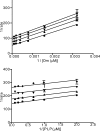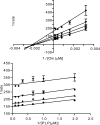Discovery of potent and selective inhibitors of Trypanosoma brucei ornithine decarboxylase
- PMID: 20220141
- PMCID: PMC2878083
- DOI: 10.1074/jbc.M109.081588
Discovery of potent and selective inhibitors of Trypanosoma brucei ornithine decarboxylase
Abstract
Human African trypanosomiasis, caused by the eukaryotic parasite Trypanosoma brucei, is a serious health problem in much of central Africa. The only validated molecular target for treatment of human African trypanosomiasis is ornithine decarboxylase (ODC), which catalyzes the first step in polyamine metabolism. Here, we describe the use of an enzymatic high throughput screen of 316,114 unique molecules to identify potent and selective inhibitors of ODC. This screen identified four novel families of ODC inhibitors, including the first inhibitors selective for the parasitic enzyme. These compounds display unique binding modes, suggesting the presence of allosteric regulatory sites on the enzyme. Docking of a subset of these inhibitors, coupled with mutagenesis, also supports the existence of these allosteric sites.
Figures






Similar articles
-
Catalytic irreversible inhibition of Trypanosoma brucei brucei ornithine decarboxylase by substrate and product analogs and their effects on murine trypanosomiasis.Biochem Pharmacol. 1985 May 15;34(10):1773-7. doi: 10.1016/0006-2952(85)90648-3. Biochem Pharmacol. 1985. PMID: 3924048
-
Polyamine metabolism: a potential therapeutic target in trypanosomes.Science. 1980 Oct 17;210(4467):332-4. doi: 10.1126/science.6775372. Science. 1980. PMID: 6775372
-
Computer-aided discovery of Trypanosoma brucei RNA-editing terminal uridylyl transferase 2 inhibitors.Chem Biol Drug Des. 2014 Aug;84(2):131-9. doi: 10.1111/cbdd.12302. Epub 2014 Jun 5. Chem Biol Drug Des. 2014. PMID: 24903413 Free PMC article.
-
Regulation and function of polyamines in African trypanosomes.Trends Parasitol. 2012 Feb;28(2):66-72. doi: 10.1016/j.pt.2011.11.001. Epub 2011 Dec 20. Trends Parasitol. 2012. PMID: 22192816 Review.
-
Cruzain inhibitors: efforts made, current leads and a structural outlook of new hits.Drug Discov Today. 2015 Jul;20(7):890-8. doi: 10.1016/j.drudis.2015.02.004. Epub 2015 Feb 16. Drug Discov Today. 2015. PMID: 25697479 Review.
Cited by
-
Design, Synthesis, and Biological Activity of Novel Ornithine Decarboxylase (ODC) Inhibitors.J Med Chem. 2025 Mar 13;68(5):5760-5773. doi: 10.1021/acs.jmedchem.4c03120. Epub 2025 Mar 4. J Med Chem. 2025. PMID: 40035393 Free PMC article.
-
Targeted protein degradation might present a novel therapeutic approach in the fight against African trypanosomiasis.Eur J Pharm Sci. 2023 Jul 1;186:106451. doi: 10.1016/j.ejps.2023.106451. Epub 2023 Apr 22. Eur J Pharm Sci. 2023. PMID: 37088149 Free PMC article.
-
Computational methods in drug discovery.Pharmacol Rev. 2013 Dec 31;66(1):334-95. doi: 10.1124/pr.112.007336. Print 2014. Pharmacol Rev. 2013. PMID: 24381236 Free PMC article. Review.
-
Organocatalytic, enantioselective synthesis of VNI: a robust therapeutic development platform for Chagas, a neglected tropical disease.Org Lett. 2012 Dec 21;14(24):6322-5. doi: 10.1021/ol303092v. Epub 2012 Dec 7. Org Lett. 2012. PMID: 23214987 Free PMC article.
-
Polyamines in protozoan pathogens.J Biol Chem. 2018 Nov 30;293(48):18746-18756. doi: 10.1074/jbc.TM118.003342. Epub 2018 Oct 17. J Biol Chem. 2018. PMID: 30333232 Free PMC article. Review.
References
-
- World Health Organization (2006) African Trypanosomiasis (Sleeping Sickness), Fact Sheet, 259 Ed., World Health Organization Media Centre, Geneva
-
- Pays E., Nolan D. P. (1998) Mol. Biochem. Parasitol. 91, 3–36 - PubMed
-
- Abdel-Monem M. M., Newton N. E., Weeks C. E. (1974) J. Med. Chem. 17, 447–451 - PubMed
Publication types
MeSH terms
Substances
Grants and funding
LinkOut - more resources
Full Text Sources
Other Literature Sources
Research Materials

